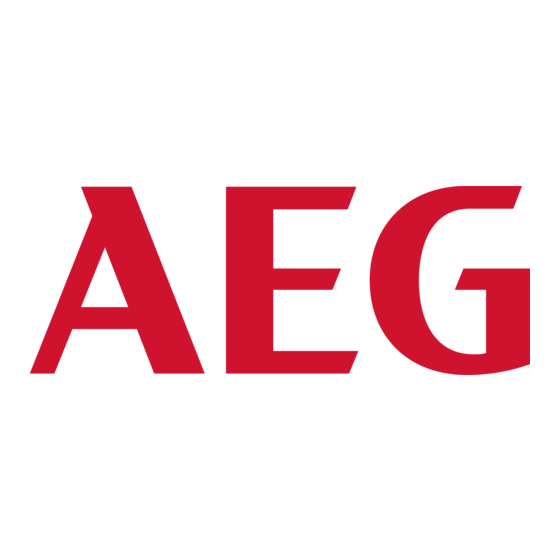
Table of Contents
Advertisement
Quick Links
Advertisement
Table of Contents

Summarization of Contents
SAFETY REGULATIONS
Information symbols
Explains symbols used in the operating instructions.
Appropriate use
Defines intended use and limitations of the device.
Obligations of the operator
Details responsibilities for personnel safety and system operation.
Safety of the system
Outlines requirements for safe system operation and maintenance.
Requirements for personnel
Specifies qualifications and training needed for personnel.
Duties of the transport personnel
Outlines safety procedures and regulations for transporting the equipment.
Type plate
Explains the information found on the device's type plate and provides an example.
IDENTIFICATION
Product brand and type designation
Lists product names, part numbers, and key technical specifications.
Name and address of the manufacturer, supplier, distributor
Provides contact details for AEG Power Solutions GmbH.
Declaration of conformity with the product standards
States compliance with relevant EU directives (LVD, EMC).
PRODUCT DESCRIPTION
General functions and area of application, intended use
Describes the device's capabilities, applications, and design features.
Overview of the front panel elements
Identifies and explains the function of front panel controls and displays.
TECHNICAL DATA
General technical data
Lists general specifications like inrush current, fuse, interference, enclosure, etc.
Type overview: Technical data
Compares technical data across different product types (AC2000, AC3000, DC2000, DC3000).
Output voltage/current derating
Illustrates how output current is affected by output voltage.
Ambient temperature derating
Shows the impact of ambient temperature on output current.
Dimension drawing
Provides detailed physical dimensions and mounting information for the device.
PREPARING THE PRODUCT FOR USE
Safety measures before use
Lists essential checks and precautions before connecting the device to power.
Unpacking
Provides instructions for safely unpacking the device and handling packaging materials.
Safe disposal of the packaging material
Guides on how to dispose of packaging components responsibly.
Preparatory work before installation
Details pre-installation checks, including leakage current and RCD usage.
Installing and mounting
Covers critical aspects of device installation, including heat sinks and connections.
Mains connection X1
Details the process and safety precautions for connecting the mains power.
DC output X2 (U )Out
Provides instructions and torque specifications for connecting the DC output.
Remote signal connections X11 and X12
Explains how to connect remote signal cables and manage shielding.
Cooling and supply air
Describes the device's cooling mechanism and air flow requirements.
OPERATING INSTRUCTIONS
Safe operation/safe functioning
General guidelines for safe and proper operation of the device.
Normal function
Explains the basic operational modes and principles of the device.
Dynamics of the output voltage
Details the voltage response to load changes and its regulation.
Setting the output voltage and output current
Guides on how to adjust output voltage and current using potentiometers.
Network monitoring
Explains mains undervoltage and overvoltage monitoring functions.
Output monitoring
Describes LED indicators and display for output voltage and current monitoring.
Reset button/functions
Explains the function of the reset button (S8) for fault acknowledgment.
LED test
Describes how to perform an LED test using button S18.
Secondary functions
Introduces functions beyond basic operation, like external controls.
External on/off switching with an external potential-free contact
How to control the device's on/off state externally.
External sensing line output voltage Uout
Explains how to use external sensing lines for voltage regulation.
External setpoint specification
Guides on setting voltage and current using external signals.
Internal setpoint specification
Details how to select and set internal voltage setpoints via terminals and potentiometers.
Actual value output
Explains how to access and interpret actual voltage and current values.
Special functions
Covers advanced operational modes like parallel operation and island networks.
Parallel operation
Discusses operating multiple units in parallel for increased reliability and performance.
Island networks
Explains protection mechanisms for stand-alone grids and transient overvoltages.
Signalling
Describes fault indications via LEDs and collective fault relay.
Block diagram
Presents a functional block diagram of the power supply unit.
MAINTENANCE AND REPAIR
Safety measures
Outlines critical safety precautions before performing maintenance or repair.
Maintenance and cleaning by the user
Provides guidelines for routine cleaning and maintenance tasks for users.
Maintenance and cleaning by qualified persons
Specifies that complex maintenance must be done by trained personnel.
Maintenance schedule
Lists recommended maintenance intervals and activities for the appliance.
Qualified AEG PS Service
Provides contact information for authorized service and support.
Troubleshooting, fault diagnosis and repair
Introduces the section on resolving common issues and faults.
No output voltage present
Lists common causes and checks for lack of output voltage.
Deviation of the output voltage
Outlines troubleshooting steps for output voltage deviations.
Spare parts list
Lists available spare parts with AEG part numbers and quantities.
DECOMMISSIONING AND DISPOSAL
Disposal
Provides instructions on how to properly dispose of the device and its components.

Need help?
Do you have a question about the AC3000 N1 and is the answer not in the manual?
Questions and answers